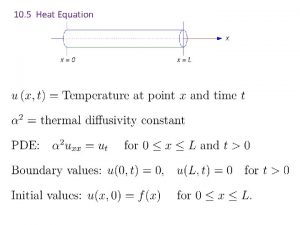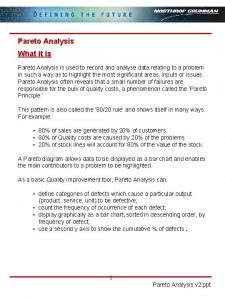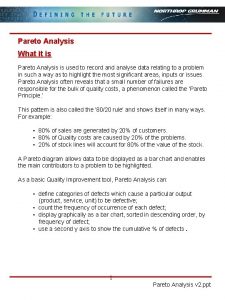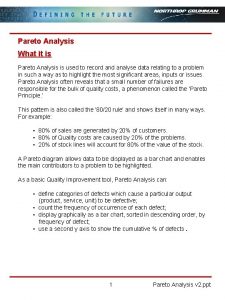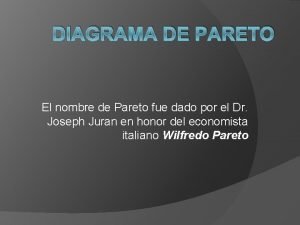Pareto Analysis The Vital Few and Trivial Many











- Slides: 11

Pareto Analysis “The Vital Few and Trivial Many” Miles M. Hamby, Ph. D. http: //milesflight. com Coppyright© 2013 Miles M. Hamby

Vilfredo Pareto July 1848 – August 1923 Italian economist • Appointed lecturer in economics, University of Lausanne, Switzerland, 1893 • 1906, observed 20% of Italian population owned 80% of the property; and 20% of pea pods in his garden accounted for 80% of his pea crop • Generalized by Joseph M. Juran into ‘Pareto principle’, or ‘ 80 -20 rule’, ie 80% of errors in a process caused by only 20% factors – “Vital Few”

The Pareto Principle • A small number of causes – the “vital few” is responsible for a large percentage of the effect – usually 20%/80% ratio. • Many applications – 20% factors cause 80% of the defects – 20% of workers do 80% of the work – 20% of the individuals will cause 80% of your headaches – In US, 20% of Americans own 94% of wealth – 20% of solutions likely to remain viable after adequate analysis – 20% of the work % and the last 10%) consume 80% of the time and resources.

The Pareto Diagram Data arranged in hierarchical order to allow most significant problems to be corrected first. Histogram of Contribution Categories (ie, causes of defects or errors) along the horizontal axis (X) and cumulative percentage or number along the vertical (Y) axis. Pareto - Press 22 x 28 Errors 100% 90% 80% 70% 60% 50% 40% 30% 20% 10% 0% F-Scuffing E-Excess Spray D-Other C-Hickeys EF E D C D D AB C AB AB A B-Misregister Cumulative Error Types A-Color Variation Cumulative contribution can be actual numbers or relative frequency (ie, percentage of the total for each contribution category.

Constructing a Pareto Diagram 1. Identify the defect Contribution Category (eg, “Defect Type” 2. Rank order them largest to smallest 3. Calculate the cumulative defects (eg, “Cumulative Defects”) for the Contribution Categories 4. (In Excel) create a bar chart with cumulative data (“Cumulative Defects”) as Y-axis and cumulative Contribution Category (“Defect Type”) as X-axis and

Example - Printing Defects Defect Type Color Variation Misregister Hickeys Other Excess Spray Scuffing Totals % Waste 22 x 28 CUM 550 150 700 50 750 30 780 16 10 806 30. 7 Repeat the procedure to create individual charts for each Press type or to create chart for “Press Type” as Contribution Category using “Totals” for Y-axis. 796 806 PRESS 38"2 C 38" Cum 77” 5 C 77"5 C Cum 430 234 27 457 31 265 45 502 80 345 37 539 21 366 21 14 574 21. 87 560 574 30 3 399 15. 2 396 399 15. 2 Press 77"4 C Cum 476 265 741 10 751 30 781 5 60 846 32. 23 786 846 Total 1690 473 185 118 72 87 2625 100

Interpretation Plotting a line along the top of each bar (Defect Type) reveals a decreasing arc, ie, a point where the contribution category (Defect Type) loses substantial contribution to the total defects. The major contribution to defects (in this example) is “Color Variation”, “Misregister”, and ‘Hickeys”. Conclusion - the best return for your efforts and resources would be to correct those processes

Interpretation 100% 90% 80% 70% 60% 50% 40% 30% 20% 10% 0% F-Scuffing E-Excess Spray D-Other C-Hickeys EF E C D D D A-Color Variation AB C AB AB C B-Misregister AB In this case, “Color Variation” and “Misregister” contribute about 85% of the defects. Pareto - Press 22 x 28 Errors A The same data converted to percentages reveals the same decreasing arc, but depicts the “ 80%” break point. Cumulative Error Types Conclusion - the best return for your efforts and resources would be to correct those processes.

Pareto in Excel

Improve the Process • Prioritize problems, goals, and objectives • Identify root causes • Select key customer relations and service programs • Select key employee relations improvement programs • Select and define key performance improvement programs • Address the Vital Few and the Trivial Many causes of nonconformance • Maximize research and product development time • Verify operating procedures and manufacturing processes • Product or services sales and distribution • Allocate physical, financial and human resources

Pareto Analysis “The Vital Few and Trivial Many” Miles M. Hamby, Ph. D. http: //milesflight. com
 Vital few objectives
Vital few objectives Adverb of little
Adverb of little Little a
Little a Fill in a little or a few
Fill in a little or a few Complete the sentences use the following words
Complete the sentences use the following words Capacidad vital y capacidad vital forzada
Capacidad vital y capacidad vital forzada Abc analysis
Abc analysis Trivial and nontrivial solution
Trivial and nontrivial solution Fill in many much (x2) few little a lot of
Fill in many much (x2) few little a lot of By many or by few
By many or by few A few a little a lot
A few a little a lot Few snow or little snow
Few snow or little snow







